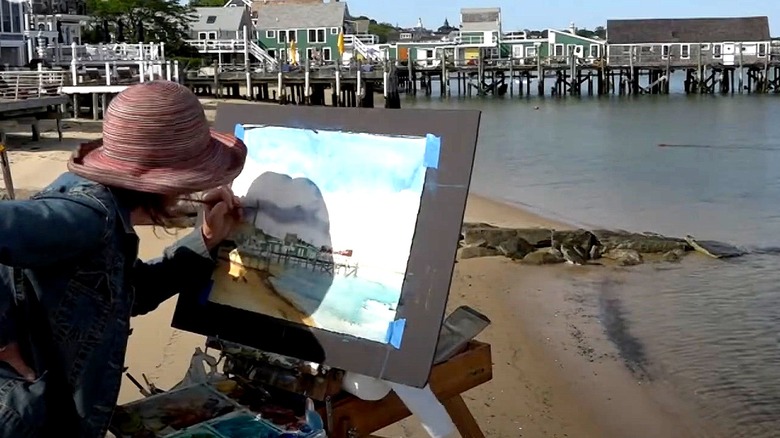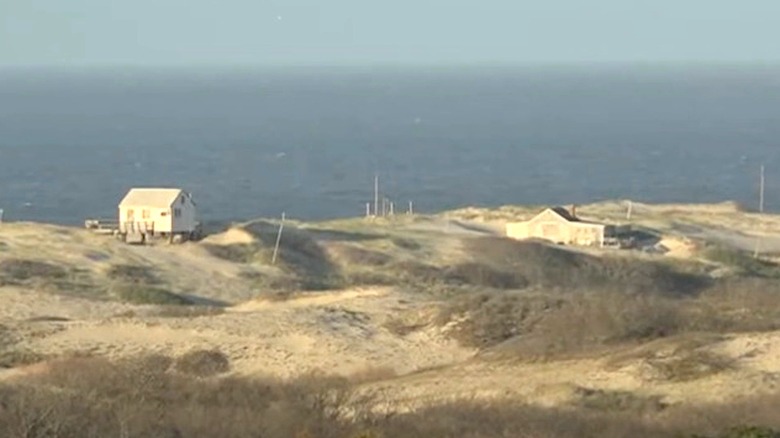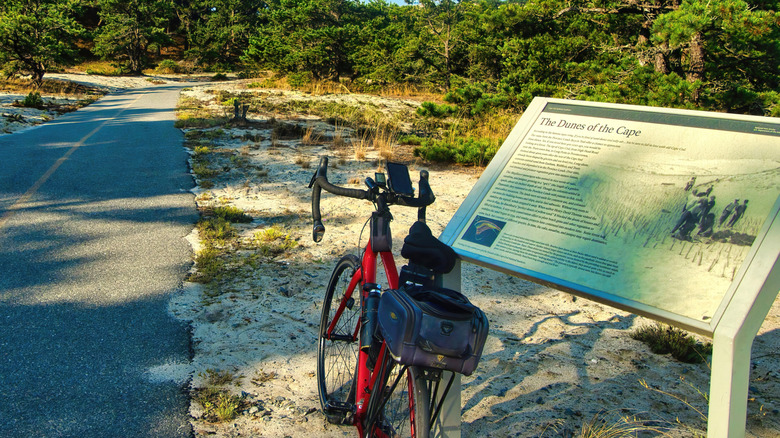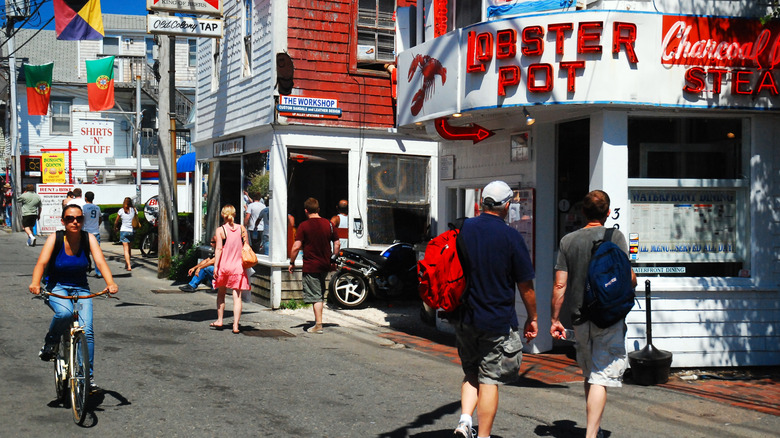America's Oldest Continuous Art Community Is A New England Gem Boasting Award-Winning Beaches
It may be difficult to imagine today, but long before Provincetown, Massachusetts, earned its standing as one of the best gay-friendly vacation destinations in the United States, the town at the outermost tip of Cape Cod was an isolated fishing and whaling outpost. And while the flamboyantly friendly energy of P-town (as it's known locally) may be front and center now — especially in the peak summer season — there's so much more to Provincetown than meets the eye, including top-rated beaches and the country's oldest established artists' colony.
The story of Provincetown's history is a whale of a tale. Originally settled by members of the indigenous Wampanoag and Nauset tribes, Provincetown was the Pilgrims' first point of landfall before they continued to head 20 miles west across Cape Cod Bay to establish Plymouth Colony. By the 1800s, skilled Portuguese fishermen were arriving in droves, drawn by the burgeoning whaling and fishing industries. But the heyday of the Provincetown's whaling industry was short-lived, and it had faded significantly by the 1870s.
The final blow came in the form of the Portland Gale of 1898. The massive storm wreaked havoc on what was left of Provincetown's maritime infrastructure, save for a few battered piers and scattered fishing shanties. But while it may have been the end of one era, it was the beginning of another. Those same worn structures, no longer used by fishermen, appealed to artists in search of studio space.
Artists followed the light to Provincetown
Drawn to the region's luminous natural light (because it's surrounded on three sides by water, Provincetown is consistently bathed in sunlight reflected off the ocean's surface), artists began setting up studios in the area's abandoned shanties. In 1899, Charles W. Hawthorne, a well-regarded American artist known for landscapes and portraiture, established the Cape School of Art, an institution devoted to plein air (outdoor) painting. The school became a cornerstone for what is now the oldest continuously running artists' colony in the United States.
Less than two decades later, Provincetown was already ranking among the most recognized art communities in the world, drawing early 20th-century art world icons including American Impressionist painters Childe Hassam and William MacGregor Paxton. Even well-known illustrator Norman Rockwell spent a summer studying at Hawthorne's Cape School of Art. But it wasn't just painters who were attracted to Provincetown. Poets, playwrights, and actors all added depth to the burgeoning art community.
In 1915, Mary Heaton Vorse, an early 20th-century activist, journalist, novelist, and avid supporter of Provincetown's art community, purchased what was left of Lewis Wharf and opened a theater. The following year, prolific American playwright Eugene O'Neill staged a production of "Bound East for Cardiff" at what by then was known as the Provincetown Playhouse. Other notable 20th-century creators who visited or lived in Provincetown at one time or another include Jack Kerouac, Jackson Pollock, Willem de Kooning, Tennessee Williams, and E.E. Cummings, many of whom — including O'Neill — set up residence in primitive beach shacks scattered across the dunes of the Outer Cape.
Dune shacks: Where the beach and the arts connect
Originally built to house members of the U.S. Life-Saving Service stationed in Provincetown, a precursor to today's U.S. Coast Guard, the dune shacks were abandoned following the 1914 opening of the Cape Cod Canal. That's when artists searching for quiet solitude began moving into the simple wooden structures. These days, visiting those shacks, or what's left of them, has become a pilgrimage of sorts for artists, nature lovers, and tourists alike who come to Provincetown to hike the Dune Shack Trail.
The two-mile round-trip hike begins at a trailhead on the northbound side of Route 6 across from Snail Road. The soft sand trail passes by wild cranberry bogs and over sand dunes before ending at a pristine stretch of north-facing beach, the location of the Dune Shacks of Peaked Hill Bars Historic District. Listed on the National Register of Historic Places, the 1,960-acre district, part of the Cape Cod National Seashore, is home to 18 National Park Services-managed early- to mid-20th-century dune shacks, some of which continue to host summer artists-in-residence stays.
Although it may seem tempting to kick off your sandals and explore the Dune Shack Trail with your bare feet, consider wearing beach shoes since, on a summer day, sand temperature can reach 120 F. Bring along plenty of water and snacks or a picnic lunch. Angel Foods on Commercial Street packs lunch to go, and Pop+Dutch is another go-to spot for to-go picnic staples. If the hike across soft sand seems daunting, consider a dune buggy tour with Art's Dune Tours or opt to take a number of easier strolls.
Provincetown by land and by sea
Clapp's Pond Loop circles a fresh-water pond through woodlands and pine stands. Downtown, the Pilgrim Monument Loop is a three-mile stroll, mostly via Commercial Street on the waterfront, that passes by private homes, shops, restaurants, and more than three dozen art galleries before ending at Pilgrim Monument. Opened in 1910, the 252-foot structure is the tallest all-granite monument in the United States. The 116-step climb opens to a viewing platform. On a clear day, it's possible to see the Boston skyline on the northwest horizon, 42 miles away. Pilgrim Monument also houses a museum that traces the history of Provincetown.
Landmarks of the culinary variety along the route include The Lobster Pot and the Provincetown Portuguese Bakery. Owned and operated by the same family since 1979, The Lobster Pot is known for lobster, of course, but its iconic red neon sign (pictured above) also enjoys landmark status, especially among artists attempting to capture its kitschy, mid-century vibe. And while the whaling and fishing industries that first drew Portuguese families to Provincetown are no longer the thriving industries they were in centuries past, Portuguese heritage is alive and well. The Provincetown Portuguese Bakery has been a downtown mainstay for almost 100 years, and the annual Provincetown Portuguese Festival and Blessing of the Fleet take place each year in June.
Another nod to Provincetown's maritime heritage, MacMillian Pier is the hub of a still-bustling waterfront, but these days streamlined fishing charters and whale-watching tour boats have replaced old-world trawlers and schooners. Visitors who prefer to stick closer to shore can stake out a spot at any one of Provincetown's top-rated beaches — where they may even catch a glimpse of a whale on the horizon.



